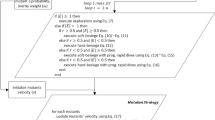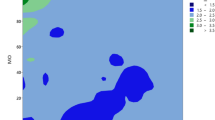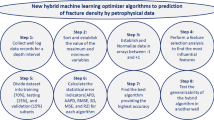Abstract
It is a problematic task to perform petro-physical property prediction of carbonate reservoir rocks in most cases, specifically for permeability prediction since a carbonate rock most commonly contains grains of heterogeneous size distributions. Consequently, the permeability calculation of tight rocks in laboratories is costly and very time-consuming. Therefore, this study aims to tackle this issue by developing novel hybrid models based on combination of the modified version of the equilibrium optimizer (EO), i.e., MEO, and two conventional machine learning algorithms, namely extreme learning machine (ELM) and artificial neural network (ANN). The MEO employs a mutation mechanism in order to avoid trapping in local optima of EO by increasing the search capabilities. In this study, ELM-MEO and ANN-MEO, novel metaheuristic ELM-based and ANN-based algorithms, were constructed to predict the permeability of tight carbonates. In addition, ANN, ELM, RF, RVM and MARS combined with particle swarm optimization and genetic programming algorithm have a better insight into the performances for preferably predicting the permeability carbonates. The results illustrate that the proposed ELM-MEO model with R2 = 0.9323, RMSE = 0.0612 and MAE = 0.0442 in training stage and R2 = 0.8743, RMSE = 0.0806 and MAE = 0.0660 in testing stage, outperformed other ELM-based and ANN-based metaheuristic models in predicting the permeability of tight carbonates at all levels.











Similar content being viewed by others
References
Ehrenberg S, Nadeau P (2005) Sandstone vs carbonate petroleum reservoirs: a global perspective on porosity-depth and porosity-permeability relationships. AAPG Bull 89(4):435–445
Harris PM (2010) Delineating and quantifying depositional facies patterns in carbonate reservoirs: Insight from modern analogs. AAPG Bull 94(1):61–86
Rashid F, Glover P, Lorinczi P, Hussein D, Collier R, Lawrence J (2015) Permeability prediction in tight carbonate rocks using capillary pressure measurements. Mar Petrol Geol 68:536–550
Brigaud B, Vincent B, Durlet C, Deconinck J-F, Blanc P, Trouiller A (2010) Acoustic properties of ancient shallow-marine carbonates: effects of depositional environments and diagenetic processes (Middle Jurassic, Paris Basin, France). J Sediment Res 80(9):791–807
Rashid F, Glover P, Lorinczi P, Hussein D, Lawrence J (2017) Microstructural controls on reservoir quality in tight oil carbonate reservoir rocks. J Petrol Sci Eng 156:814–826
Goh A, Zhang W, Zhang Y, Xiao Y, Xiang Y (2018) Determination of earth pressure balance tunnel-related maximum surface settlement: a multivariate adaptive regression splines approach. Bull Eng Geol Environ 77(2):489–500
Goh AT, Zhang Y, Zhang R, Zhang W, Xiao Y (2017) Evaluating stability of underground entry-type excavations using multivariate adaptive regression splines and logistic regression. Tunnel Undergr Space Technol 70:148–154
Wang L, Wu C, Tang L, Zhang W, Lacasse S, Liu H et al (2020) Efficient reliability analysis of earth dam slope stability using extreme gradient boosting method. Acta Geotech 15(11):3135–3150
Zhang W, Li H, Wu C, Li Y, Liu Z, Liu H (2020) Soft computing approach for prediction of surface settlement induced by earth pressure balance shield tunneling. Undergr Space. https://doi.org/10.1016/j.undsp.2019.12.003
Zhang W, Zhang R, Wu C, Goh ATC, Lacasse S, Liu Z et al (2020) State-of-the-art review of soft computing applications in underground excavations. Geosci Front 11(4):1095–1106
Zhang W, Li Y, Chongzhi WU, Hongrui Li, Goh A, Zhang R (2020) Prediction of lining response for twin-tunnel construction in anisotropic clays using machine learning techniques. Undergr Space. https://doi.org/10.1016/j.undsp.2020.02.007
Zhu L, Zhang C, Zhang C, Wei Y, Zhou X, Cheng Y et al (2018) Prediction of total organic carbon content in shale reservoir based on a new integrated hybrid neural network and conventional well logging curves. J Geophys Eng 15(3):1050–1061
Onalo D, Adedigba S, Khan F, James LA, Butt S (2018) Data driven model for sonic well log prediction. J Petrol Sci Eng 170:1022–1037
Onalo D, Oloruntobi O, Adedigba S, Khan F, James L, Butt S (2019) Dynamic data driven sonic well log model for formation evaluation. J Petrol Sci Eng 175:1049–1062
Zhu L, Zhang C, Zhang C, Zhang Z, Zhou X, Zhu B (2019) An improved theoretical nonelectric water saturation method for organic shale reservoirs. IEEE Access 7:51441–51456
Xue Y, Cheng L, Mou J, Zhao W (2014) A new fracture prediction method by combining genetic algorithm with neural network in low-permeability reservoirs. J Petrol Sci Eng 121:159–166
Wang H, Wu W, Chen T, Dong X, Wang G (2019) An improved neural network for TOC, S1 and S2 estimation based on conventional well logs. J Petrol Sci Eng 176:664–678
Lim J-S, Kim J (2004) Reservoir porosity and permeability estimation from well logs using fuzzy logic and neural networks. In: SPE Asia Pacific oil and gas conference and exhibition. Society of Petroleum Engineers.
Tang H (2008) Improved carbonate reservoir facies classification using artificial neural network method. In: Canadian international petroleum conference. OnePetro
Tang H, Meddaugh WS, Toomey N (2011) Using an artificial-neural-network method to predict carbonate well log facies successfully. SPE Reserv Eval Eng 14(1):35–44
Zhou X, Zhang C, Zhang Z, Zhang R, Zhu L, Zhang C (2019) A saturation evaluation method in tight gas sandstones based on diagenetic facies. Mar Petrol Geol 107:310–325
Zhu L-q, Zhang C, Wei Y, Zhang C-m (2017) Permeability prediction of the tight sandstone reservoirs using hybrid intelligent algorithm and nuclear magnetic resonance logging data. Arab J Sci Eng 42(4):1643–1654
Zhu L, Zhang C, Wei Y, Zhou X, Huang Y, Zhang C (2017) Inversion of the permeability of a tight gas reservoir with the combination of a deep Boltzmann kernel extreme learning machine and nuclear magnetic resonance logging transverse relaxation time spectrum data. Interpretation 5(3):T341–T350
Faramarzi A, Heidarinejad M, Stephens B, Mirjalili S (2020) Equilibrium optimizer: a novel optimization algorithm. Knowl Based Syst 191:105190
Kardani N, Bardhan A, Samui P, Nazem M, Zhou A, Armaghani DJ (2021) A novel technique based on the improved firefly algorithm coupled with extreme learning machine (ELM-IFF) for predicting the thermal conductivity of soil. Eng Comput 1:1–20
Wang L, Chongzhi Wu, Tang L, Zhang W, Lacasse S, Liu H, Gao L (2020) Efficient reliability analysis of earth dam slope stability using extreme gradient boosting method. Acta Geotech 15(11):3135–3150
Kardani N, Zhou A, Nazem M, Shen S-L (2020) Estimation of bearing capacity of piles in cohesionless soil using optimised machine learning approaches. Geotech Geol Eng 38(2):2271–2291
Zhang R, Wu C, Goh AT, Böhlke T, Zhang W (2020) Estimation of diaphragm wall deflections for deep braced excavation in anisotropic clays using ensemble learning. Geosci Front 12(1):365–373
Chen L, Zhang W, Gao X, Wang L, Li Z, Böhlke T, Umberto (2020) Design charts for reliability assessment of rock bedding slopes stability against bi-planar sliding: SRLEM and BPNN approaches. Georisk. https://doi.org/10.1080/17499518.2020.1815215
Kardani MN, Baghban A, Hamzehie ME, Baghban M (2019) Phase behavior modeling of asphaltene precipitation utilizing RBF-ANN approach. Petrol Sci Technol 37(16):1861–1867
Kardani N, Zhou A, Nazem M, Lin X (2021) Modelling of municipal solid waste gasification using an optimised ensemble soft computing model. Fuel 289:119903
Gupta S, Deep K, Mirjalili S (2020) An efficient equilibrium optimizer with mutation strategy for numerical optimization. Appl Soft Comput 96:106542
Zhang W, Wu C, Zhong H, Li Y, Wang L (2021) Prediction of undrained shear strength using extreme gradient boosting and random forest based on Bayesian optimization. Geosci Front 12:469–477
Kennedy J, Eberhart R (1995) Particle swarm optimization. In: Proceedings of ICNN'95-international conference on neural networks, vol. 4. IEEE, pp 1942–1948.
Ho TK (1995) Random decision forests. In: Proceedings of 3rd international conference on document analysis and recognition, vol 1. IEEE, pp 278–282
Kardani N, Zhou A, Nazem M, Shen S-L (2021) Improved prediction of slope stability using a hybrid stacking ensemble method based on finite element analysis and field data. J Rock Mech Geotech Eng 13(1):188–201
Zhang W, Wu C, Li Y, Wang L, Samui P (2019) Assessment of pile drivability using random forest regression and multivariate adaptive regression splines. Georisk Assess Manag Risk Eng Syst Geohazards 15:1–14
Zhang W, Zhang R, Wu C, Goh AT, Wang L (2020) Assessment of basal heave stability for braced excavations in anisotropic clay using extreme gradient boosting and random forest regression. Undergr Space. https://doi.org/10.1016/j.undsp.2020.03.001
Kardani N, Bardhan A, Kim D, Samui P, Zhou A (2020) Modelling the energy performance of residential buildings using advanced computational frameworks based on RVM, GMDH, ANFIS-BBO and ANFIS-IPSO. J Build Eng 35:102105
Tipping ME (2000) The relevance vector machine. In: Solla S, Leen T, Mu¨ller K (eds) Advances in neural information processing systems, vol 12. MIT Press, pp 652–658
Viswanathan R, Jagan J, Samui P, Porchelvan P (2015) Spatial variability of rock depth using simple kriging, ordinary kriging, RVM and MPMR. Geotech Geol Eng 33(1):69–78
Wang L, Chongzhi W, Xin G, Liu H, Mei G, Zhang W (2020) Probabilistic stability analysis of earth dam slope under transient seepage using multivariate adaptive regression splines. Bull Eng Geol Environ. https://doi.org/10.1007/s10064-020-01730-0
Wengang Z, Runhong Z, Wei W, Fan Z, Goh ATC (2019) A Multivariate adaptive regression splines model for determining horizontal wall deflection envelope for braced excavations in clays. Tunnel Undergr Space Technol 84:461–471
Zhang W, Goh ATC (2013) Multivariate adaptive regression splines for analysis of geotechnical engineering systems. Comput Geotech 48:82–95
Zhang W, Goh ATC (2016) Multivariate adaptive regression splines and neural network models for prediction of pile drivability. Geosci Front 7(1):45–52
Zhang W, Zhang Y, Goh AT (2017) Multivariate adaptive regression splines for inverse analysis of soil and wall properties in braced excavation. Tunnel Undergr Space Technol 64:24–33
Deo RC, Samui P (2017) Forecasting evaporative loss by least-square support-vector regression and evaluation with genetic programming, Gaussian process, and minimax probability machine regression: case study of Brisbane City. J Hydrol Eng 22(6):05017003
Holland JH (1992) Genetic algorithms. Sci Am 267(1):66–73
Samui P, Dalkiliç Y, Jagan J (2015) Site characterization using GP. MARS and GPR handbook of genetic programming applications. Springer, Berlin, pp 345–357
Al Khalifah H, Glover P, Lorinczi P (2020) Permeability prediction and diagenesis in tight carbonates using machine learning techniques. Mar Petrol Geol 112:104096
Barton C, Woods M, Bristow C, Newall A, Westhead R, Evans DJ et al (2011) Geology of south Dorset and south-east Devon and its World Heritage Coast: special memoir for 1: 50,000 geological sheets 328 Dorchester, 341/342 West Fleet and Weymouth and 342/343 Swanage, and parts of sheets 326/340 Sidmouth, 327 Bridport, 329 Bournemouth and 339 Newton Abbot. British Geological Survey
Ray R, Kumar D, Samui P, Bahadur Roy L, Goh ATC, Zhang W (2021) Application of soft computing techniques for shallow foundation reliability in geotechnical engineering. Geosci Front 12:375–383
Taylor KE (2001) Summarizing multiple aspects of model performance in a single diagram. J Geophys Res Atmosp 106(D7):7183–7192
Bi J, Bennett KP (2003) Regression error characteristic curves. In: Proceedings of the 20th international conference on machine learning (ICML-03), pp 43–50
Kumar M, Bardhan A, Samui P, Hu JW, Kaloop RM (2021) Reliability analysis of pile foundation using soft computing techniques: a comparative study. Processes 9(3):486
Zhang W, Li H, Li Y, Liu H, Chen Y, Ding X (2021) Application of deep learning algorithms in geotechnical engineering: a short critical review. Artif Intell Rev. https://doi.org/10.1007/s10462-021-09967-1
Acknowledgements
This work was financially supported by the High-end Foreign Expert Introduction program (No. G20200022005) and Science and Technology Research Program of Chongqing Municipal Education Commission (No. KJCXZD2020002).
Author information
Authors and Affiliations
Contributions
NK contributed to conceptualization, methodological development, development of AI models, overall analysis, and manuscript finalization; AB contributed to conceptualization, development of AI models, methodological development, detailing, overall analysis, and manuscript finalization; SG contributed to development of Improved EO algorithm and methodological development; PS was involved in reviewing and editing; MN contributed to reviewing and editing; YMZ contributed to guidance, reviewing, editing, and manuscript finalization; and AZ contributed to guidance, reviewing, editing, and manuscript finalization.
Corresponding authors
Ethics declarations
Conflict of interest
The authors declare that they have no conflict of interest statement.
Additional information
Publisher's Note
Springer Nature remains neutral with regard to jurisdictional claims in published maps and institutional affiliations.
Rights and permissions
About this article
Cite this article
Kardani, N., Bardhan, A., Gupta, S. et al. Predicting permeability of tight carbonates using a hybrid machine learning approach of modified equilibrium optimizer and extreme learning machine. Acta Geotech. 17, 1239–1255 (2022). https://doi.org/10.1007/s11440-021-01257-y
Received:
Accepted:
Published:
Issue Date:
DOI: https://doi.org/10.1007/s11440-021-01257-y




